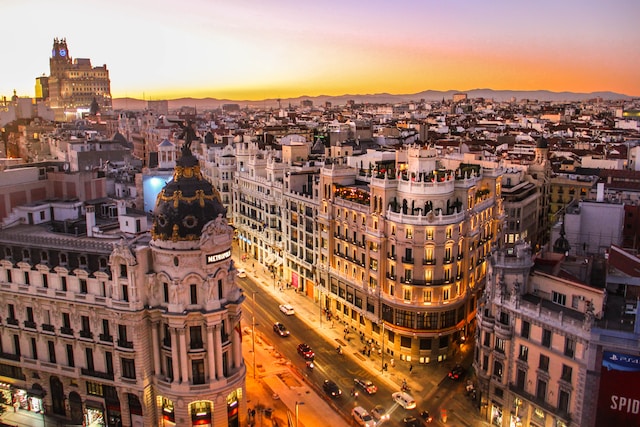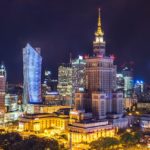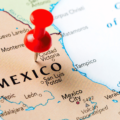Welcome to Madrid, Spain’s bustling capital and a hotspot for digital nomads seeking an urban lifestyle brimming with culture, history, and delicious cuisine. This vibrant city offers remote workers an affordable cost of living compared to other European capitals, fast internet speeds and a plethora of coworking spaces catering to their needs.
In this comprehensive guide, we will uncover the best neighbourhoods for digital nomads in Madrid, top attractions you can’t miss out on and practical information that ensures your life as a digital nomad in this beautiful city is as smooth and enjoyable as possible.
Key Takeaways
- Madrid offers an affordable cost of living for digital nomads, with average monthly expenses of around $3,999 and several neighbourhood options to choose from.
- Digital nomads can find various accommodation options in Madrid, including long-term rentals and co-living spaces.
- Madrid has a vibrant coworking scene, with top options like Google Campus Madrid and Impact Hub Madrid. There are also numerous cafes ideal for remote work such as Toma Café or HanSo Cafe.
- Public transport is an efficient way to get around the city, with the metro system covering most parts of town while taxis and ride-sharing services offer reliable alternatives. Must-try local dishes include Cocido Madrileño, Churros con Chocolate or Gambas al Ajillo.
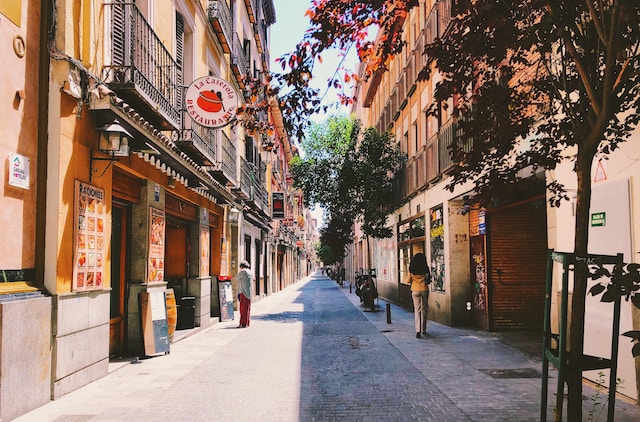
Living And Working In Madrid As A Digital Nomad
Living and working in Madrid as a digital nomad offers urban lifestyle in one of Europe’s central bases, with the city ranking #123 out of all cities for digital nomads.
Cost Of Living In Madrid
One of the main factors attracting digital nomads to Madrid is the city’s relatively affordable cost of living. On average, a digital nomad can expect to spend around $3,999 per month, while locals typically pay about $1,331 per month.
In terms of specific expenses for digital nomads in Madrid, renting a one-bedroom apartment in a trendy neighbourhood like Malasaña or La Latina could cost anywhere from $900 to $1500 per month.
Utilities and high-speed internet are usually included in rental prices. Eating out at local restaurants serving delicious Spanish cuisine won’t break your budget either – you can enjoy tapas and drinks with friends without worrying too much about your wallet.
Best Neighbourhoods For Digital Nomads
Madrid offers a variety of neighbourhoods with unique personalities, making it a popular destination for digital nomads. Here are some of the best neighbourhoods to consider when moving to Madrid:
- Sol: Known as the city centre, Sol provides easy access to all parts of Madrid and hosts numerous coworking spaces, cafes, and cultural activities.
- Retiro: Situated near the stunning Parque del Retiro, this upscale area boasts beautiful architecture and a peaceful atmosphere while being close to the city’s major attractions.
- Malasaña: A hub for creativity and artistic expression, Malasaña is home to diverse cafes, bars, boutique shops, and lively nightlife. The neighbourhood is known for its LGBTQ+ friendly environment.
- Lavapies: Recognised for its multicultural atmosphere, Lavapies offers affordable living options alongside an array of international restaurants and vibrant street art.
- Salamanca: As one of Madrid’s most prestigious districts, Salamanca features luxurious shopping streets and renowned museums such as Museo del Prado. This neighbourhood may have higher living costs but provides excellent quality of life.
Each of these areas caters to different lifestyles while granting digital nomads a fantastic urban experience in Spain’s capital city.
Accommodation Options For Digital Nomads
When it comes to finding a place to stay in Madrid, digital nomads can choose from a variety of options, including long-term rentals and co-living spaces.
Finding Long-Term Rentals
Finding long-term rentals in Madrid can prove to be a challenge for digital nomads, as landlords often favour local tenants and require at least a 12-month lease.
However, there are various platforms that cater specifically to the needs of remote workers seeking longer stays.
To give you an idea of cost, a private room in central Madrid will typically set you back between €300-450 per month while studio or one-bedroom flats range from €600-800 per month.
Remember that prices can vary depending on factors such as location and seasonality.
Co-Living Spaces
Digital nomads in Madrid can enjoy co-living spaces as a popular and affordable accommodation option. Co-living offers the chance to share living spaces with like-minded individuals, which reduces expenses significantly.
These communities are designed for remote workers with all-inclusive rates that cover utilities, Wi-Fi, and other amenities like housekeeping and laundry services.
Sharing space encourages connectivity while helping expats feel at home quicker since they meet new people faster than otherwise would be possible when staying alone in hotels or renting apartments.
Co-Working Spaces And Cafes In Madrid
Discover the best co-working spaces in Madrid, such as Goya Smart Coworking, The Shed Coworking, and Espiritu 23 to network with other remote workers.
Top Co-Working Spaces
Madrid is home to a variety of vibrant co-working spaces, catering to the needs of digital nomads. Here are some of the top options for those looking for a comfortable and productive work environment:
- Google Campus Madrid: This tech hub and co-working space offers an extensive range of resources for startups and entrepreneurs, including high-speed internet, meeting rooms, and training programs.
- Impact Hub Madrid: This global network of co-working spaces provides a collaborative atmosphere for creative professionals with access to essential resources such as printers, scanners, and other office equipment.
- La Guarida Coworking: Located in the trendy Sol neighbourhood, this cozy co-working space offers top-quality facilities with free coffee and fast Wi-Fi that keeps you connected throughout the day.
- Goya Smart Coworking: Centrally located in the upscale Salamanca district, this modern co-working space offers elegantly designed private offices and shared workspaces equipped with all necessary amenities.
- Espiritu 23: This airy co-working space in Chamberi is ideal for freelancers who need a quiet setting to focus on their work. There are different pricing options available depending on your workspace needs.
These co-working spaces offer digital nomads with an opportunity to be more productive while enjoying a vibrant Madrid lifestyle. They come fully equipped with high-speed internet, meeting rooms, events for networking and learning opportunities that help digital nomads thrive in their chosen profession.
Best Cafes For Remote Work
If you’re a digital nomad in Madrid looking for the perfect place to work, look no further! Here are some of the best cafes for remote work:
- Toma Café – This trendy cafe in Malasaña offers excellent coffee and a relaxed atmosphere, perfect for getting work done.
- La Bicicleta – This popular cafe in Lavapies has plenty of seating options and is known for its super-fast WiFi.
- Café de la Luz – Located in Chamberi, this cozy cafe has plenty of natural light and a quiet atmosphere, great for productivity.
- Federal Café – This Australian-inspired cafe in Chueca offers delicious brunch options and ample workspace, making it a top pick for digital nomads.
- HanSo Cafe – With locations throughout Madrid, HanSo Cafe offers high-speed WiFi and a minimalist interior that’s perfect for focusing on your work.
Remember to order a coffee or snack to support these businesses while you work!
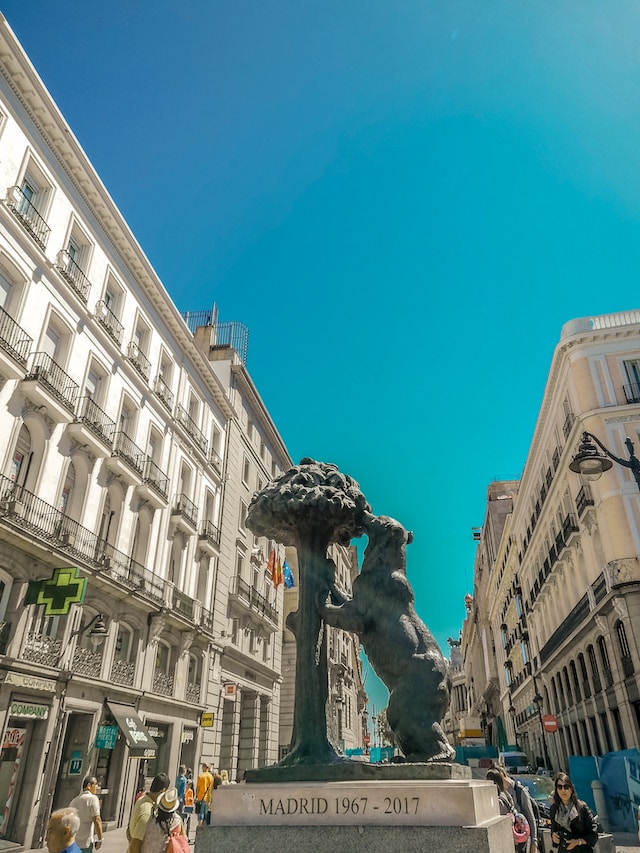
Madrid climate/weather
Madrid has a Mediterranean climate with continental influences. Summers are hot and dry, with average temperatures in July and August of 25-30 degrees Celsius (77-86 degrees Fahrenheit). Winters are cold and dry, with average temperatures in January and February of 0-5 degrees Celsius (32-41 degrees Fahrenheit).
The city receives very little rainfall throughout the year, with an average annual rainfall of 400 millimeters (16 inches). The driest months are July and August, when the city receives less than 10 millimeters (0.4 inches) of rainfall.
The climate in Madrid can be quite extreme, with large swings in temperature between day and night. It is important to dress in layers when visiting Madrid, so that you can adjust to the changing temperatures.
Here is a more detailed look at the climate in Madrid:
- Summer: Summer is the warmest and driest season in Madrid. The average temperature in July and August is 25-30 degrees Celsius (77-86 degrees Fahrenheit). The city receives very little rainfall during the summer, with an average monthly rainfall of less than 10 millimeters (0.4 inches).
- Autumn: Autumn is a pleasant season in Madrid. The weather is warm and sunny, with average temperatures in September and October of 20-25 degrees Celsius (68-77 degrees Fahrenheit). The city receives a little more rainfall during the autumn, with an average monthly rainfall of 50-75 millimeters (2-3 inches).
- Winter: Winter is the coldest season in Madrid. The average temperature in January and February is 0-5 degrees Celsius (32-41 degrees Fahrenheit). The city receives very little rainfall during the winter, with an average monthly rainfall of 25-50 millimeters (1-2 inches).
- Spring: Spring is a beautiful season in Madrid. The weather is warm and sunny, with average temperatures in March and April of 15-20 degrees Celsius (59-68 degrees Fahrenheit). The city receives a little more rainfall during the spring, with an average monthly rainfall of 50-75 millimeters (2-3 inches).
Overall, the climate in Madrid is quite variable. The city experiences hot summers, cold winters, and little rainfall throughout the year. It is important to dress in layers and be prepared for the changing temperatures when visiting Madrid.
Transportation In Madrid
Get around Madrid with ease using the city’s advanced public transport options, including the metro system and buses, or take advantage of ride-sharing services like Uber and Cabify.
Public Transport Options
Madrid has a great public transport system, which is affordable and efficient for digital nomads to explore the city easily. The Madrid Metro covers most parts of the city, with over 300 stops on 15 lines that run from 6 am to 1:30 am every day.
In addition to the metro, buses are also available throughout the city with tickets priced similarly as those of metro options. Digital Nomads can purchase an unlimited monthly pass for €54.60 allowing full access to both metros and buses all center zones included .
Taxis And Rideshare Services
Madrid’s taxis and ride-sharing services are reliable options for getting around the city. Taxis can be hailed on the street or picked up at a designated taxi stand, and their rates are regulated and metered.
Ride-sharing services like Uber and Cabify also offer affordable prices, especially for longer rides. The Madrid metro system is also convenient and affordable, with over 300 stops across its 15 lines.
However, if you prefer to take a taxi or ride-share service in Madrid, they are generally safe options with reliable drivers.
Keywords: Madrid, taxis, ride-sharing services, Uber, Cabify, metro system
Food And Dining In Madrid
Indulge in Madrid’s culinary delights and must-try local dishes like paella, churros con chocolate, and cocido madrileño.
Must-Try Local Dishes
Madrid is known for its diverse food scene that offers plenty of options to try out. Here are some must-try local dishes to whet your appetite as a digital nomad:
- Cocido Madrileño – a hearty stew made with beef, pork, chickpeas, and vegetables.
- Huevos Rotos – fried potatoes served with broken eggs, chorizo or ham.
- Churros con Chocolate – churros, crispy deep-fried dough served with hot chocolate sauce for dunking.
- Tortilla Española – thick Spanish omelette made with potatoes and onions.
- Gambas al Ajillo – garlic prawns cooked in olive oil, wine and chili flakes.
- Callos a la Madrileña – tripe stew with chorizo sausage and morcilla blood sausage.
- Patatas Bravas – crispy fried potatoes served with spicy tomato sauce and aiolidipping sauce.
- Croquetas de Jamón – small bites made of creamy béchamel sauce mixed with bits of Serrano ham before being breaded and deep-fried.
- Cochinillo Asado – roasted suckling pig served tender and juicy on your plate.
- Bocadillo de Calamares – a popular street food that consists of fried squid rings piled onto a baguette-style bread roll.
Trying these dishes is a great way to immerse yourself in Madrid’s culture and cuisine while keeping your taste buds happy as you work remotely from this amazing city!
Top Tapas Restaurants
When in Madrid as a digital nomad, trying the local tapas is a must. Here are some of the top tapas restaurants to check out:
- Casa Toni – A classic spot in Sol known for their delicious croquettes and traditional Spanish tavern atmosphere.
- El Sur – Located in La Latina, this small and cozy spot offers modern twists on classic tapas dishes like patatas bravas and grilled octopus.
- Juana la Loca – A trendy bar in the heart of La Latina that serves unique tapas like truffled egg toast with Iberian ham and wild mushroom risotto.
- Taberna Real – An elegant restaurant near the Royal Palace that specializes in Castilian cuisine and has been frequented by famous politicians and celebrities.
- Mercado de San Miguel – A bustling indoor market with numerous food stalls offering various types of tapas, including oysters, Iberian ham, and seafood paella.
Whether you’re on a budget or looking to splurge, Madrid’s tapas scene has something for everyone. Don’t miss out on experiencing one of Spain’s most iconic culinary traditions while working remotely as a digital nomad.
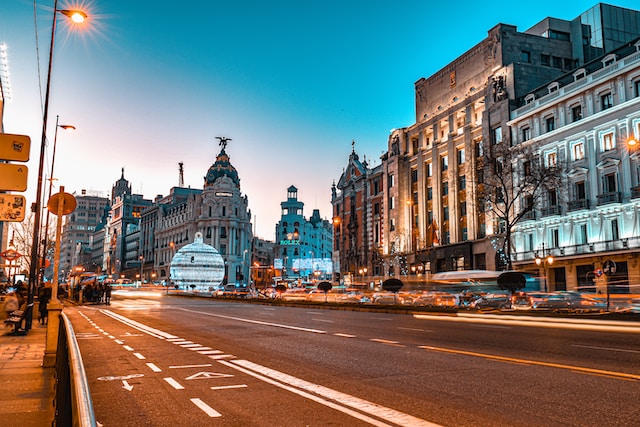
Cultural Insights And Etiquette
In Madrid, it’s important to be mindful of the local customs and etiquette, such as avoiding excessive public display of affection and respecting siesta culture.
Public Display Of Affection
Madrid is known for its relaxed attitude towards public displays of affection. Hand-holding and a quick peck on the cheek are considered appropriate forms of PDA, particularly between couples.
However, it’s important to be mindful of cultural differences and respect local customs when showing affection in public. Excessive displays of affection, such as making out in public, may be frowned upon.
While PDA between same-sex couples is generally accepted in Madrid – which is known for being LGBTQ+ friendly – being too explicit with displays of affection should still be avoided.
Fun fact: Public displays of affection are so common and socially acceptable in Madrid that if you walk around some popular parks or squares at night you’ll even find groups playing ‘intecambios’ (language exchange) where people kiss strangers from all over the world!
Siesta Culture
Siesta is a serious tradition in Madrid and plays a significant role in Spanish culture. During the midday hours, businesses and stores are closed to allow people to take a break from the hustle and bustle of daily life.
Visitors should observe siesta times when planning their outings as some attractions may be closed during this period. However, digital nomads can use this time to explore Madrid’s vibrant barrios or enjoy lunch at one of its famous tapas restaurants.
Safety And Security For Digital Nomads In Madrid
Madrid is generally considered a safe city, but digital nomads should take necessary precautions to ensure their safety and security while living and working there. One common issue in Madrid is pickpocketing, which can happen in crowded areas like tourist attractions or on public transport.
It’s important for digital nomads to be aware of their surroundings at all times and take necessary measures to prevent any potential incidents from occurring. This includes keeping valuables out of sight and not leaving them unattended in public places.
In addition to physical safety, it’s important for digital nomads to protect themselves digitally as well by utilizing secure networks when accessing sensitive information like bank accounts or important documents.
By taking necessary safety measures both physically and digitally while living as a digital nomad in Madrid, individuals can enjoy all the benefits that this vibrant city has to offer with confidence.
Visa Requirements For Digital Nomads In Spain
If you’re planning to stay in Madrid for an extended period of time as a digital nomad, it’s essential to understand Spain’s visa requirements.
Length Of Stay With Spanish Visa
If you plan to stay in Madrid as a digital nomad for an extended period, it’s essential to understand the length of stay with a Spanish visa. Digital nomads can stay up to 90 days without a visa, but longer stays require obtaining one.
The length of your stay will vary depending on the type of visa obtained, which may include study visas or work visas for self-employment.
For example, if you’re planning on staying in Madrid for more than six months, you may consider applying for a non-lucrative residence permit. This permit is specifically designed for those who are not looking to engage in any employment activities while living in Spain.
It allows individuals to live in Spain for up to one year initially and then can be renewed every two years after that period has expired.
Required Documents For Spanish Visa
To obtain a Spanish visa for a long-term stay, digital nomads should prepare the following documents:
- Application form: Fill out the Spanish visa application form accurately and completely.
- Passport: Provide a valid passport with at least 6 months of validity beyond the intended stay in Spain.
- Additional passport-quality photo: Attach one recent passport-size photograph to the application.
- Flight information: Show proof of a round-trip ticket or detailed travel itinerary.
- Proof of accommodation: Provide evidence of where you plan to stay during your visit to Spain, such as hotel reservations or rental agreements.
- Medical certificate: Obtain a medical certificate showing that you are in good health and free from any contagious diseases.
- Proof of financial means: Prove that you have sufficient funds to support yourself financially during your stay in Spain without needing to work there illegally.
- Health insurance coverage: Obtain health insurance coverage for the entirety of your stay in Spain, including emergency medical treatment and repatriation expenses.
- Clean criminal record: Submit a document showing that you do not have any criminal history or pending charges in your home country.
It is important to note that these documents must be presented in person at the Spanish consulate or embassy in your home country. Additionally, all documents not originally provided in Spanish must be officially translated by certified translators into Spanish before submission. For more information on required documents and other details about obtaining a Spanish visa, consult with an immigration lawyer who specializes in this area.
Spain Digital Nomad visa
-
- The digital nomad visa is a residence permit that allows non-EU citizens to live and work remotely in Spain for up to 12 months.
- To be eligible for the visa, you must:
- Be a citizen of a country that is not part of the European Economic Area (EEA) or Switzerland.
- Have a valid passport and a health insurance plan that covers you for the duration of your stay in Spain.
- Have a minimum monthly income of €2,334.
- Be able to prove that you have the necessary skills and experience to work remotely.
- You can apply for the visa at a Spanish consulate or embassy in your home country.
- The application process typically takes several weeks.
- Once you have been granted the visa, you will be able to live and work in Spain for up to 12 months.
- You can renew the visa for up to a total of 5 years.
Top Attractions And Activities For Digital Nomads In Madrid
Explore the beautiful Parque del Retiro, take a bike tour through Madrid’s vibrant barrios, discover over 35,000 works of art at the Museo del Prado, catch a Real Madrid game at Santiago Bernabeu Stadium and indulge in traditional tapas dishes like cocido and huevos rotos.
Parque Del Retiro
Parque del Retiro is a stunning park situated in the heart of Madrid, perfect for escaping the busy city streets and enjoying nature. The park offers a range of outdoor activities, such as walking or cycling around its picturesque trails or renting rowboats to paddle on the serene lake.
Visitors can also marvel at contemporary art exhibitions showcased at Palacio de Cristal, located within the park’s boundaries.
The Buen Retiro Gardens are beautifully landscaped areas with unique gardens, fountains and sculptures tucked into corners throughout the park. With various cafes and restaurants scattered throughout Parque del Retiro, visitors can grab a quick snack or meal while enjoying their surroundings.
Museo Del Prado
The Museo del Prado is a must-visit attraction for digital nomads in Madrid, located conveniently in the Retiro neighbourhood. This museum is home to an impressive collection of European art, featuring works by famous artists such as Goya and Velazquez.
Digital nomads can enjoy free admission if they are under 18 years old or take advantage of discounted rates available for students and seniors. The museum building itself is remarkable, with grand entrances and spacious galleries making it ideal to explore solo or with friends.
Guided tours and an audio guide app are also available to enhance the experience, while the adjacent Retiro park provides a serene atmosphere should visitors need a break from sightseeing.
Real Madrid Football Club
Visiting the Santiago Bernabeu stadium and watching Real Madrid Football Club play a game is a must-do for football fans in Madrid. The world-renowned club has won numerous championships and boasts some of the greatest players of all time, including Cristiano Ronaldo, Zinedine Zidane, and Ferenc Puskás.
Not only can visitors watch games at the stadium, but they can also take tours that allow them to access different areas of the complex, such as locker rooms, trophy displays, and even pitchside views.
And if you’re not a football fan? No worries! There’s still much to see at Santiago Bernabeu Stadium – its history and architecture alone make it worth exploring.
Pros And Cons Of Living In Madrid As A Digital Nomad
Madrid offers a unique blend of history, culture, and modern amenities, making it an attractive destination for digital nomads. However, like any city, it has its pros and cons. Here is an overview of the advantages and disadvantages of living in Madrid as a digital nomad:
| Pros | Cons |
|---|---|
| Good quality of life and community score. | Expensive cost of living. |
| Fast internet speed (average 21Mbps). | Low English speaking level. |
| Safe city with low crime rates and great hospitals. | Difficulty in finding accommodation and dishonest landlords. |
| Friendly to foreigners, LGBTQ+ friendly, and good freedom of speech. | English menus in restaurants are not widely available. |
| Low population density and great for walking. | Locals mostly speak only Spanish outside of tourist areas. |
| Warm climate with 350 sunny days a year. | Very hot summers. |
| Good transportation system and excellent rail links within Spain. |
Conclusion
In conclusion, Madrid offers digital nomads a fabulous destination to set up base. Its affordable cost of living, vibrant barrios and the convenience of transportation makes it an attractive city for remote work.
Tourist attractions such as El Rastro flea market, Museo del Prado, and Real Madrid Football Club are just a few examples of what you can fit into your itinerary when taking a break from work.
While there are challenges such as language barriers and cultural differences to navigate, working in Madrid provides opportunities to experience the multicultural atmosphere that Spain is known for first-hand.
FAQs:
1. What are some popular coworking spaces in Madrid for digital nomads?
Madrid has a range of coworking spaces that cater to the specific needs of digital nomads, such as Impact Hub Madrid, We Work and La Guarida Coworking. These offer flexible membership plans and comfortable office environments with high-speed internet access.
2. What is the cost of living like for digital nomads in Madrid?
Overall, the cost of living in Madrid is relatively affordable compared to other major cities in Europe. Accommodation costs typically range between €400 – €800 per month depending on location and amenities, while eating out or grabbing drinks at bars can vary from inexpensive local spots to higher-end restaurants.
3. How easy is it to find short-term accommodation options for digital nomads in Madrid?
There are plenty of options when it comes to finding short-term rental accommodations suitable for digital nomads including platforms like Airbnb or Uniplaces which offer fully furnished apartments with flexible lease terms ranging from a few weeks up to several months.
4. What should I know about working remotely from Spain as a self-employed or freelance worker?
If you’re planning on setting up operations in Spain as a self-employed/freelance worker – also known as being “autónomo” – you will need to register yourself with relevant authorities before beginning work legally while adhering tax laws domestically & internationally where necessary. It’s recommended that individuals consult an accountant or lawyer who specializes in these matters prior taking any action until completely familiarized with political landscape & legal requirements applicable under Spanish law system so there are no unexpected surprises down road
